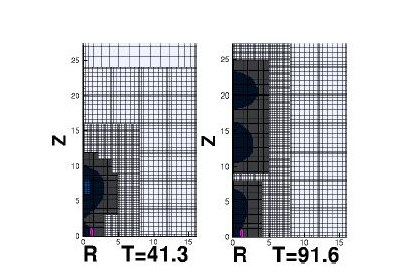A hierarchical block structured space-time spectral element method for simulating complex multiphase flows
题目:A hierarchical block structured space-time spectral element method for simulating complex multiphase flows
地点:浙江大学玉泉校区教十一, 417室
时间:2018年5月29日 10:30-11:30
报告人:Prof. Mark Sussman, Florida State University, Mathematics Department.
Abstract:A new parallelized hierarchical space-time spectral element method has been developed for simulating multiphase compressible or incompressible flows in which the bulk regions of one or more of the fluids can be complex. Such flows occur in the study of ocean currents[7],atomization and spray in combustion engines[3], and bubbly flows[8].
In previous work in simulating multiphase flows on a hierarchical block structured adaptive grid[3, 2], the level of efficiency of dynamic adaptive mesh refinement had to be decreased because the numerical solution on coarse levels was overly damped, resulting in incorrect feedback on multiphase interface(s), or retarding naturally occurring nonlinear flow phenomena.
We shall present original work in which the solution in spectral elements spanning a single material is represented with space-time spectral accuracy [4, 6, 5]. The discretization in multi-material (> 1 material) elements is the same as in our previous work [2]. Our present hierarchical adaptive mesh strategy is to prescribe the highest order spectral elements on the coarse adaptive levels, and progressively reduce the order on finer levels. See Figure 1 in which we show the simulation of bubble formation at a nozzle corresponding to the experiments of Helsby and Tuson [1]. A relatively easy to implement multigrid preconditioned BiCGSTAB (MGPBiCG) algorithm has been developed for the variable density projection equation on our new hierarchical adaptive spectral element grid. The efficiency of the MGPBiCG solver is comparable to that of the lower order MGPCG counterpart.
References
[1] FW Helsby and KR Tuson. Behaviour of air bubbles in aqueous solutions. Research, 8:270, 1955.
[2] Matthew Jemison, Mark Sussman, and Marco Arienti. Compressible, multiphase semi-implicit method with moment of fluid interface representation. Journal of Computational
Physics, 279:182-217, 2014.

Figure 1: Simulation of bubble formation (density ratio 1015:1, viscosity ratio 6924:1) on a hierarchical spectral element grid. Coarsest Level: 1×3 16th order elements; Level 1: 8th order elements; Level 2: 4th order elements; Finest Level: uniform mesh. The results are in agreement with experiments [1] (Figure 1E). The deforming bubble boundary is simulated using the moment of fluid method [2].
[3] Xiaoyi Li and Marios C Soteriou. High fidelity simulation and analysis of liquid jet atomization in a gaseous crossowflow at intermediate weber numbers. Physics of Fluids (1994-present), 28(8):082101, 2016.
[4] C. Pei, M. Sussman, and M.Y. Hussaini. A space-time discontinuous galerkin spectral element method for the stefan problem. Discrete and Continuous Dynamical Systems Series B (online frist), 2017.
[5] C. Pei, M. Sussman, and M.Y. Hussaini. New multi-implicit space time spectral element methods for advection diffusion reaction problems. Journal of Scientific Computing (Online First), pages 1-34, 2018.
[6] C. Pei, M. Sussman, and M.Y. Hussaini. A space time discontinuous galerkin spectral element method for nonlinear hyperbolic problems. International Journal of Computational Methods, ACCEPTED, 2018.
[7] Carlowen A Smith, Kevin G Speer, and Ross W Griffiths. Multiple zonal jets in a differentially heated rotating annulus*,+.Journal of Physical Oceanography, 44(9):2273-2291, 2014.
[8] Aaron M Thomas, Jun Fang, Jinyong Feng, and Igor A Bolotnov. Estimation of shear-induced lift force in laminar and turbulent flows. Nuclear Technology, 190(3):274-291, 2015.
联系人: 张庆海(0015089@zju.edu.cn)




